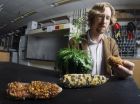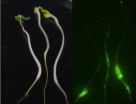(Press-News.org) WEST LAFAYETTE, Ind. - Physical defects in plants can be predicted based on chromosome imbalances, a finding that may shed light on how the addition or deletion of genes and the organization of the genome affects organisms, according to a study involving a Purdue University researcher.
The findings identify easily measured characteristics that vary with imbalances of specific chromosomes, said Brian Dilkes, a Purdue assistant professor of horticulture. Understanding why and how those imbalances result in certain characteristics could open the door to correcting those defects in not only plants, but also in animals and humans.
A classic example in humans is in Down syndrome, which is caused by an extra copy of chromosome 21.
"The ability of an organism to replicate and pass on all its genes is incredibly important," Dilkes said. "What we've found is that genes are sensitive to their dose relative to the rest of the genome. When that balance is disrupted, the organisms fail."
In plants, an imbalance in chromosome number can cause defects in stems, leaves, flowers and other physical features. Understanding how those imbalances cause changes could allow scientists to manipulate plant traits to increase biomass for fuels or other purposes.
"By learning the rules, we can predict the outcome of adding or deleting a gene from an organism," Dilkes said. "We see predictable physical consequences for variation in chromosome dosages. This problem is tractable."
Dilkes, a co-author of the findings released in the early online version of the journal Genetics, was part of a team as a project scientist at the University of California-Davis Genome Center that studied chromosome dosage in the research plant Arabidopsis thaliana. The team used naturally occurring and laboratory-created plants with multiple copies of each chromosome, called polyploids, and then crossed them to create aneuploids, or plants with an irregular number of chromosomes.
The aneuploids, which had either an excess or deficiency of a chromosome, were tested to see which chromosomes were deficient or excessive. Those plants were then phenotyped, recording their physical characteristics. The phenotypes and chromosome imbalances were compared, and it became clear that more or less of particular chromosomes corresponded to specific phenotypic characteristics.
Plants with excess chromosome 1 and a deficiency of chromosome 3 had increased stem diameter, for example. To test the finding, plants were created that had both an excess of chromosome 1 and were deficient in chromosome 3, and stem diameter grew as predicted.
In a surprising turn, the team found that chromosomal imbalance resulted in abnormal traits expressed in its offspring. Plants with a normal number of chromosomes that were descended from plants with chromosome imbalances should have been normal but still displayed abnormal characteristics.
"Something about those chromosomes is different," Dilkes said. "We have no idea what that something is, but it suggests there are multigenerational consequences to changes in chromosome dosage. The DNA sequence says these plants should be perfectly normal, but they are not."
Dilkes said future research would focus on chromosome imbalances in crop plants such as corn and trying to understand how the excess or deficiency of a gene leads to a particular phenotypic characteristic.
INFORMATION:
The National Science Foundation funded the research.
Writer: Brian Wallheimer, 765-496-2050, bwallhei@purdue.edu
Source: Brian Dilkes, 765-494-2584, bdilkes@purdue.edu
PHOTO CAPTION:
Brian Dilkes was part of a team that determined that plant physical defects can be predicted based on chromosome imbalances. (Purdue Agricultural Communication photo/Tom Campbell)
A publication-quality photo is available at dilkes-chromosomes.jpg
Abstract on the research in this release is available at: http://www.purdue.edu/newsroom/research/2010/101103DilkesChromosomes.html
Chromosome imbalances lead to predictable plant defects
2010-11-04
ELSE PRESS RELEASES FROM THIS DATE:
E. coli thrives near plant roots, can contaminate young produce crops
2010-11-04
WEST LAFAYETTE, Ind. - E. coli can live for weeks around the roots of produce plants and transfer to the edible portions, but the threat can be minimized if growers don't harvest too soon, a Purdue University study shows.
Purdue scientists added E. coli to soil through manure application and water treated with manure and showed that the bacteria can survive and are active in the rhizosphere, or the area around the plant roots, of lettuce and radishes. E. coli eventually gets onto the aboveground surfaces of the plants, where it can live for several weeks. Activity in ...
U of M researcher finds public support for HPV vaccine wanes when linked to controversy
2010-11-04
MINNEAPOLIS / ST. PAUL, Minn. (Nov. 2, 2010) – The vaccine that protects against the potentially cancer-causing human papillomavirus (HPV) enjoys wide support in the medical and public health communities. Yet state laws to require young girls to be vaccinated as a requirement for middle school attendance have aroused controversy with parents, politicians, and even medical and public health experts disagreeing about whether such laws are appropriate. News coverage about HPV vaccine requirements tends to amplify this controversy, possibly leading to negative attitudes among ...
Organic onions, carrots and potatoes do not have higher levels of healthful antioxidants
2010-11-04
With the demand for organically produced food increasing, scientists are reporting new evidence that organically grown onions, carrots, and potatoes generally do not have higher levels of healthful antioxidants and related substances than vegetables grown with traditional fertilizers and pesticides. Their study appears in ACS' bi-weekly Journal of Agricultural and Food Chemistry.
In the study, Pia Knuthsen and colleagues point out that there are many reasons to pay a premium for organic food products. The most important reasons for the popularity of organic food products ...
Built-in timer for improving accuracy of cost saving paper-strip medical tests
2010-11-04
Scientists are reporting the development of a simple, built-in timer intended to improve the accuracy of paper tests and test strips for diagnosing diseases inexpensively at-home and elsewhere. Their study appears in ACS' semi-monthly journal Analytical Chemistry.
Scott Phillips and Hyeran Noh note that so-called point-of-care tests include paper strip tests and others performed at home or bedside instead of in laboratories. They show special promise for improving medical care in developing countries and reducing health care costs elsewhere. When fully developed, these ...
Does adolescent stress lead to mood disorders in adulthood?
2010-11-04
Montreal, November 3, 2010 – Stress may be more hazardous to our mental health than previously believed, according to new research from Concordia University. A series of studies from the institution have found there may be a link between the recent rise in depression rates and the increase of daily stress.
"Major depression has become one of the most pressing health issues in both developing and developed countries," says principal researcher Mark Ellenbogen, a professor at the Concordia Centre for Research in Human Development and a Canada Research Chair in Developmental ...
Electrons get confused
2010-11-04
Scientists from Helmholtz-Zentrum Berlin (HZB) observed exotic behaviour from beryllium oxide (BeO) when they bombarded it with high-speed heavy ions: After being shot in this way, the electrons in the BeO appeared "confused", and seemed to completely forget the material properties of their environment. The researchers' measurements show changes in the electronic structure that can be explained by extremely rapid melting around the firing line of the heavy ions. If this interpretation is correct, then this would have to be the fastest melting ever observed. The researchers ...
Levels of coumarin in cassia cinnamon vary greatly even in bark from the same tree
2010-11-04
A "huge" variation exists in the amounts of coumarin in bark samples of cassia cinnamon from trees growing in Indonesia, scientists are reporting in a new study. That natural ingredient in the spice may carry a theoretical risk of causing liver damage in a small number of sensitive people who consume large amounts of cinnamon. The report appears in ACS' bi-weekly Journal of Agricultural and Food Chemistry.
Friederike Woehrlin and colleagues note that cinnamon is the second most popular spice, next to black pepper, in the United States and Europe. Cinnamon, which comes ...
Small materials poised for big impact in construction
2010-11-04
Bricks, blocks, and steel I-beams — step aside. A new genre of construction materials, made from stuff barely 1/50,000th the width of a human hair, is about to debut in the building of homes, offices, bridges, and other structures. And a new report is highlighting both the potential benefits of these nanomaterials in improving construction materials and the need for guidelines to regulate their use and disposal. The report appears in the monthly journal ACS Nano.
Pedro Alvarez and colleagues note that nanomaterials likely will have a greater impact on the construction ...
Transparent conductive material could lead to power-generating windows
2010-11-04
UPTON, NY - Scientists at the U.S. Department of Energy's (DOE) Brookhaven National Laboratory and Los Alamos National Laboratory have fabricated transparent thin films capable of absorbing light and generating electric charge over a relatively large area. The material, described in the journal Chemistry of Materials, could be used to develop transparent solar panels or even windows that absorb solar energy to generate electricity.
The material consists of a semiconducting polymer doped with carbon-rich fullerenes. Under carefully controlled conditions, the material self-assembles ...
Video-game technology may speed development of new drugs
2010-11-04
Parents may frown upon video games, but the technology used in the wildly popular games is quietly fostering a revolution in speeding the development of new products and potentially life-saving drugs. That's the topic of an article in the current issue of Chemical & Engineering News (C&EN), ACS' weekly newsmagazine.
C&EN Associate Editor Lauren K. Wolf notes that consumer demand for life-like avatars and interactive scenery has pushed computer firms to develop inexpensive yet sophisticated graphics hardware called graphics processing units, or GPUs. The graphical units ...





